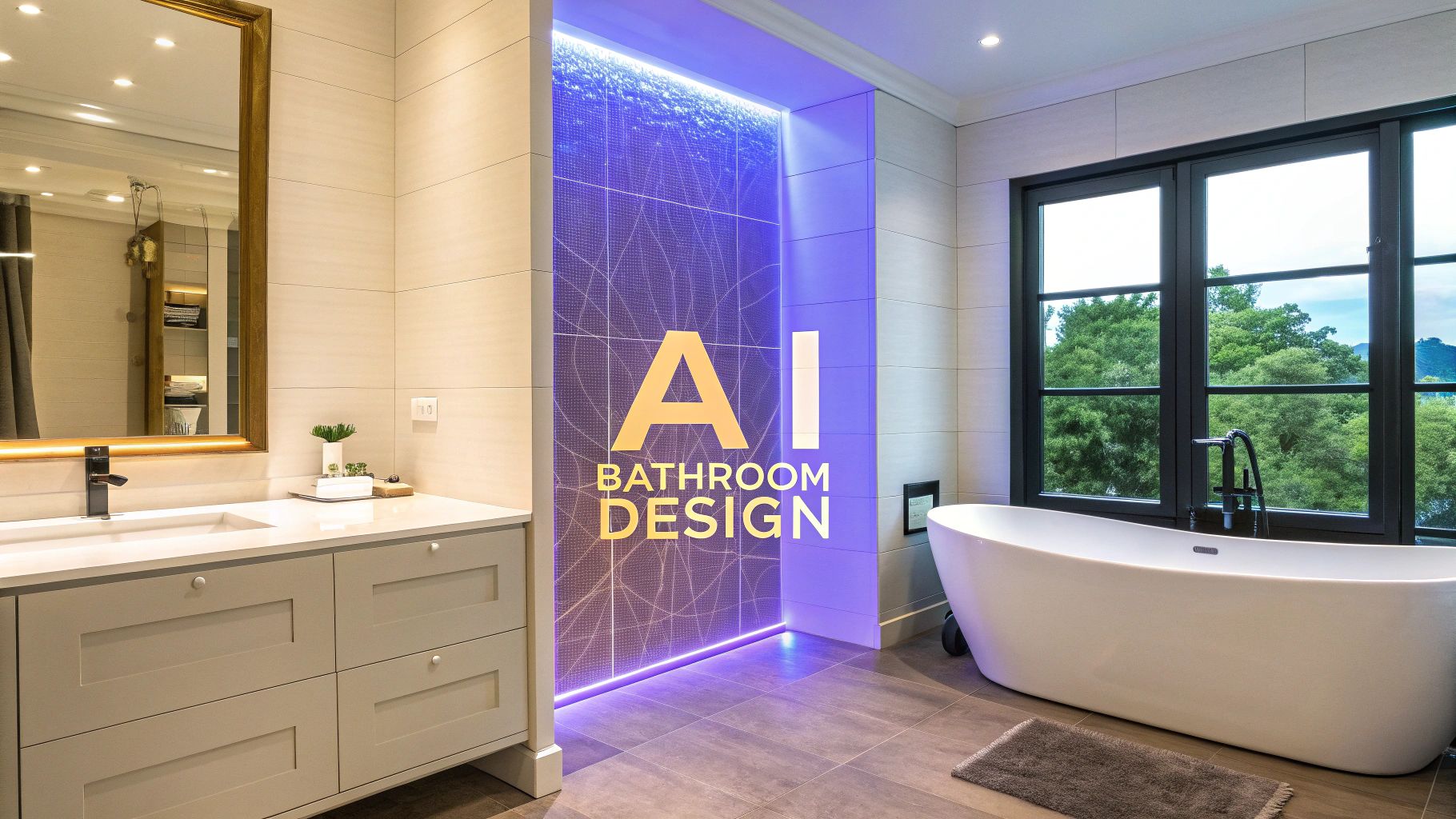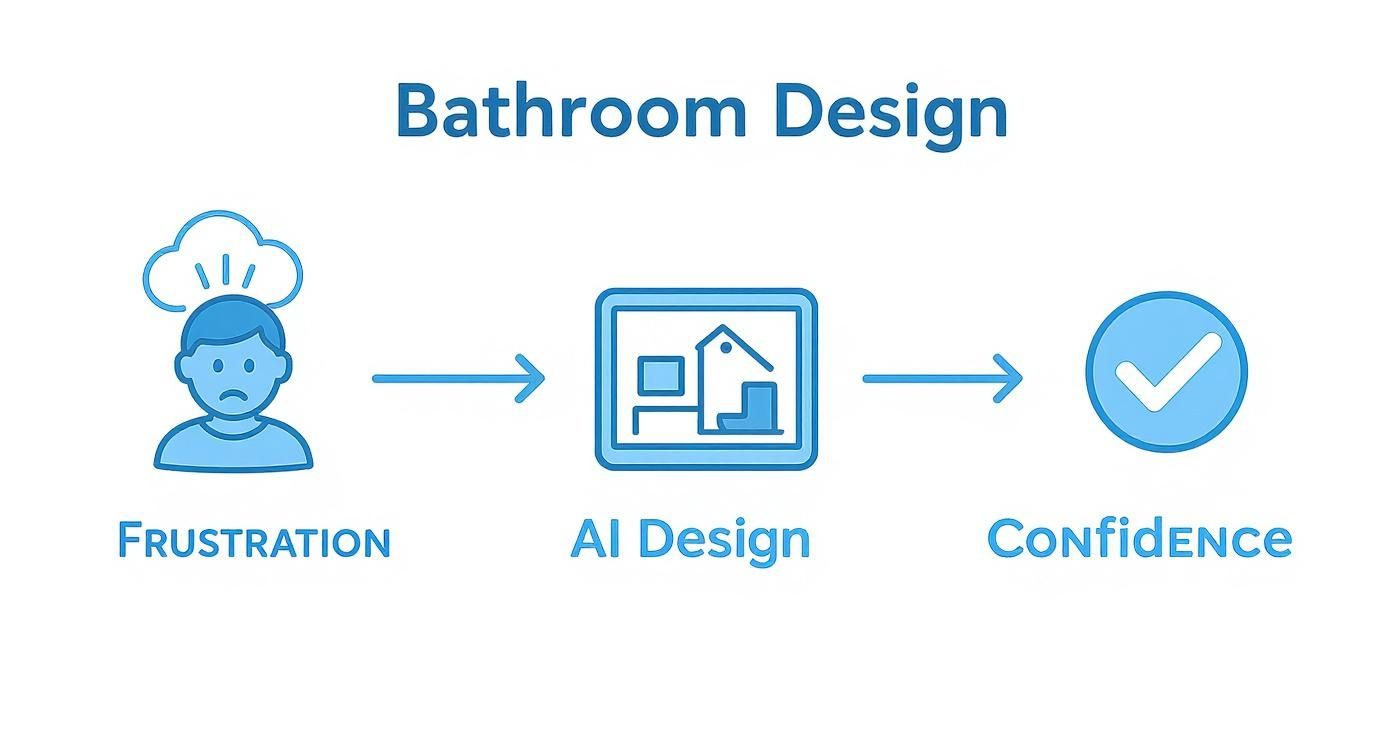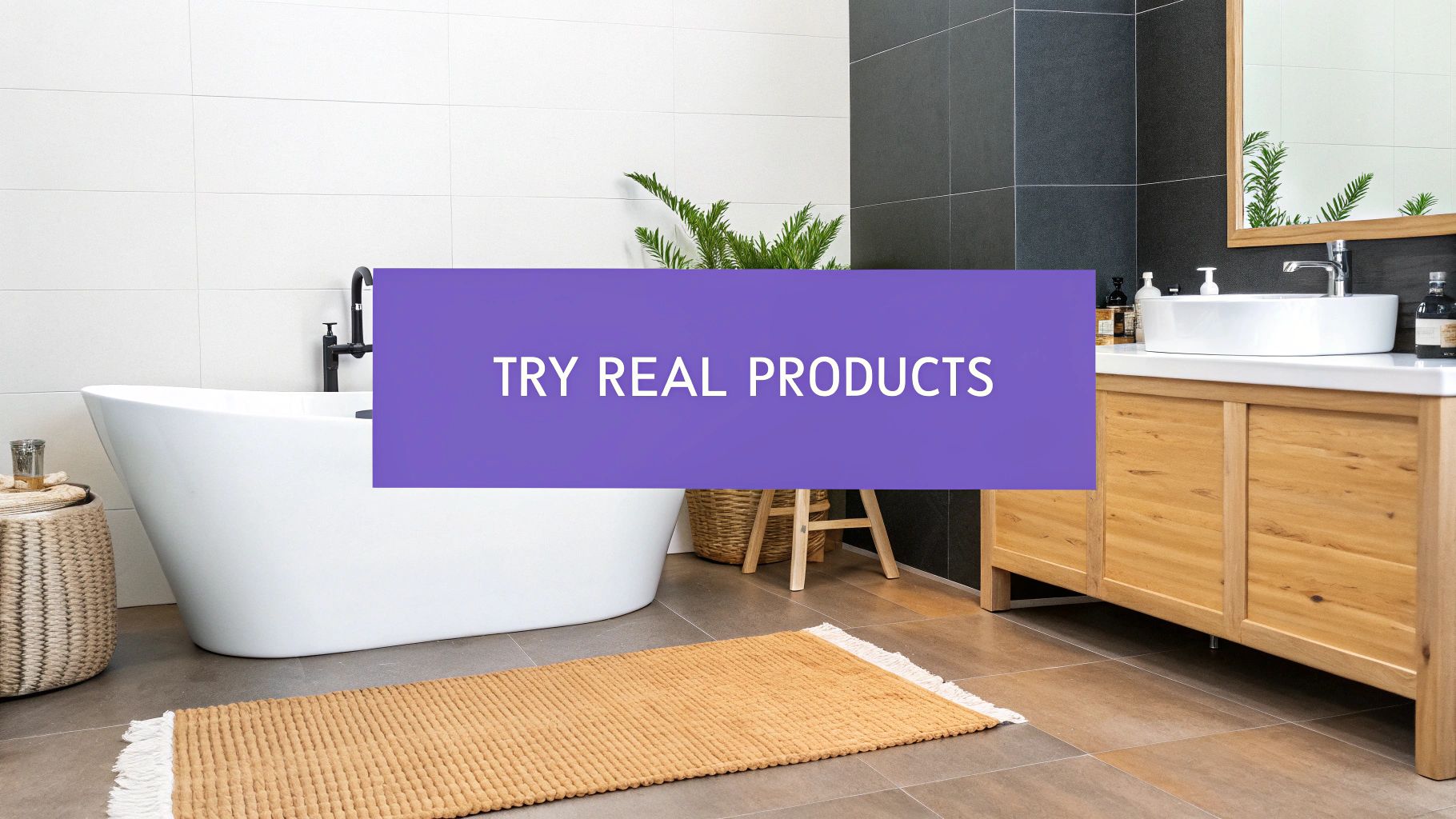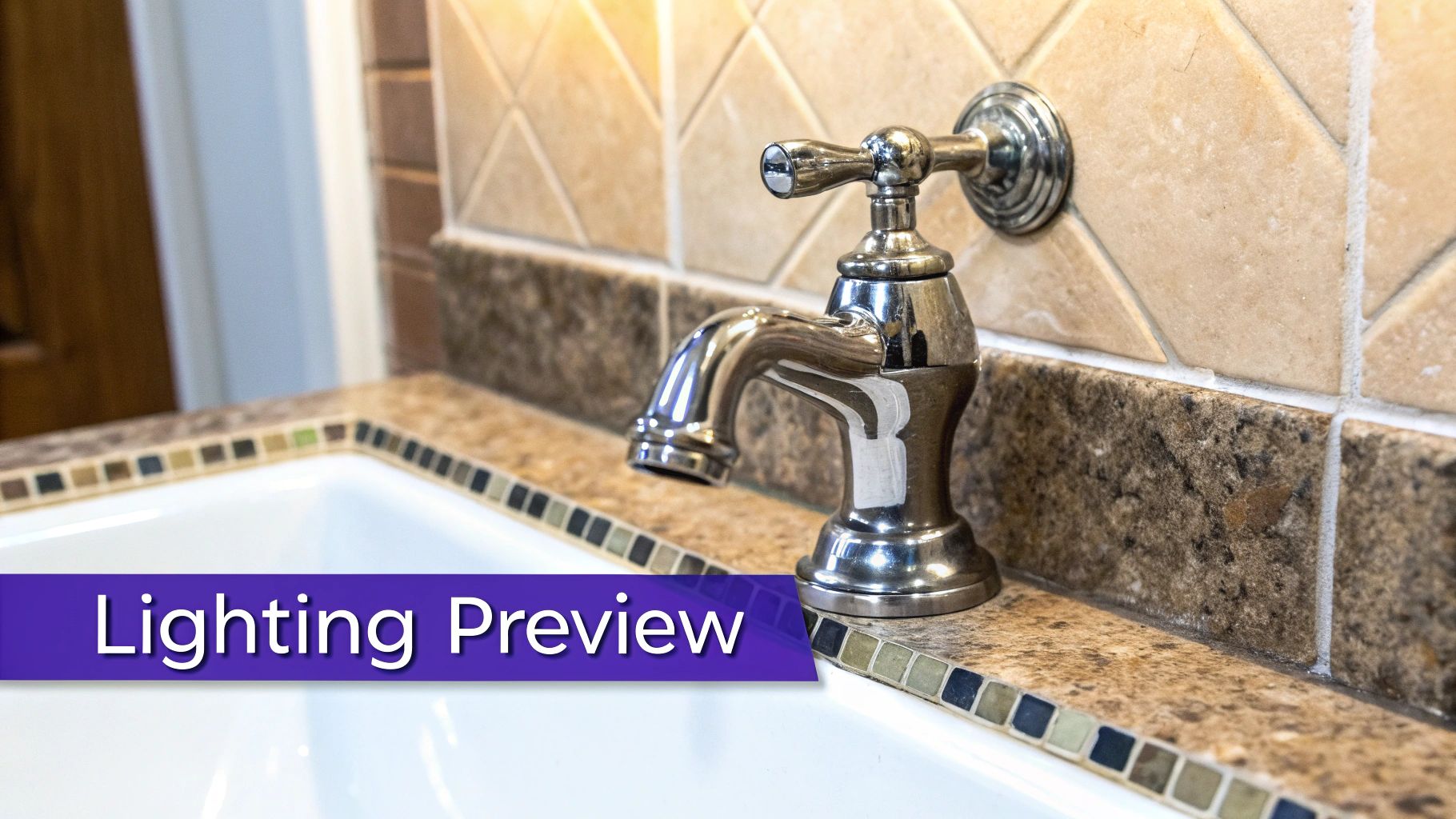AI Bathroom Design Visualizing Your Perfect Space
Explore how AI bathroom design tools create realistic, true-to-scale plans. Visualize products from real brands in your room before you start your remodel.

We’ve all been there, standing in a bathroom, surrounded by a dozen tile samples and paint chips, trying to imagine how it will all come together. It’s a frustrating guessing game. But what if you could skip the guesswork entirely? AI bathroom design does just that, creating incredibly realistic previews of your finished space before you ever lift a hammer.
This isn’t about just making a pretty picture; it’s about bridging that tricky gap between the idea in your head and the final reality.
Say Goodbye to Remodeling Guesswork
The biggest headache in any bathroom renovation is the uncertainty. You fall in love with a vanity online or a tile pattern in a magazine, but figuring out how those pieces will actually look and feel in your bathroom is a real challenge. This often leads to second-guessing, expensive mistakes, or a finished room that just feels… off.
That’s where AI-powered design tools come in. They completely change the game by letting you see your ideas in photorealistic detail, taking the "hope for the best" out of the equation.
From Vague Ideas to A Clear Picture
Tools like aiStager are leading this charge. What makes this kind of technology so powerful is that aiStager is the only solution that generates hyper-realistic photos with true dimension rooms and furniture objects. We're not talking about a generic 3D model; we're talking about a digital twin of your actual bathroom.
The process is surprisingly straightforward. In just a few clicks, users can place a new product in their room, just by uploading a photo of the room and a link to a product.
Let's say you're stuck between two vanities for your new Modern Farmhouse bathroom. You could drop in a sleek, dark wood design from Restoration Hardware, and then, a moment later, swap it for a rustic, reclaimed oak piece from a different brand. With a few more clicks, you can even test different colors and finishes for the same vanity, instantly seeing which one truly fits the vibe you're going for.
The real magic here is eliminating buyer's remorse before it even has a chance to set in. When you can visualize real products in your actual space, you make confident decisions that save a ton of time and money down the road.
Trying Out Real Products, Perfectly Sized
This is where things get really practical. You can compare a matte black faucet to a brushed gold one, or see how large-format tiles from your favorite brand look next to a classic subway tile.
Since a tool like aiStager uses the product's actual dimensions, you can finally confirm whether that gorgeous freestanding tub you've had your eye on will actually fit without making the room feel cramped. This level of precision gives you the confidence to pull the trigger on big-ticket items.
To see how much this approach changes things, let's compare the old way of doing things with the new AI-powered workflow.
Comparing Design Methods
| Milestone | Traditional Remodel Planning | AI-Powered Design (with aiStager) |
|---|---|---|
| Initial Concept | Mood boards, magazine clippings, paint swatches | Upload a room photo and start visualizing immediately |
| Product Selection | Guessing how items from different stores will look together | Virtually "place" real products from any retailer into your space |
| Scale & Layout | Tape on the floor, manual measurements, hoping it fits | True-to-scale models confirm fit and placement instantly |
| Style Variations | A time-consuming process of ordering many samples | Generate dozens of style variations in minutes |
| Final Decision | Based on imagination and a bit of hope | Based on a photorealistic preview of the final result |
It's pretty clear that seeing is believing. The AI approach removes the ambiguity and replaces it with clarity, making the entire process feel less like a gamble and more like a well-planned project.
As you start to move beyond the old ways of designing, it’s a good idea to keep an eye on what’s next. You can check out some of the top bathroom trends for 2025, including smart tech to get inspired.
AI design is part of a much bigger shift toward smarter homes. In fact, the global smart bathroom market is expected to jump from USD 10.19 billion to USD 24.83 billion by 2034. You can dig into the data on PolarisMarketResearch.com. This proves that technology isn't just a gimmick—it's quickly becoming a standard for creating spaces that are not only beautiful but also built for the future.
Setting the Stage for Your Digital Design
Before you can really get creative with AI design tools, you have to give the software a good, solid starting point. Think of it like this: an artist can't paint a portrait without seeing the person's face. The quality of what you put in—your photos and measurements—directly dictates the quality of what you get out.
This first step is what turns a pretty, but generic, Pinterest picture into a genuinely useful planning tool. It’s the key difference between just liking a freestanding tub and knowing for a fact that it will actually fit in the space you have.
This whole process is about moving from that initial "where do I even start?" frustration to making confident, informed decisions.

As you can see, the AI is really the bridge that connects the uncertainty of a remodel with the clarity of a well-executed plan.
Capturing the Perfect Shot
The photo you feed the AI is the canvas for your entire design. You don't need to be a professional photographer—your phone will do just fine—but a few simple tricks will give the software the best information to work with.
First, natural light is your best friend. Open the blinds, throw back the curtains, and turn on every light in the room. This gets rid of harsh shadows and helps the AI see all the existing textures and colors accurately.
Next, get into a corner or stand in the doorway to fit as much of the room into one photo as you can. This gives the software the full picture of your layout. If you want to get even more precise, new tech makes it surprisingly easy to scan a room to create a 3D model right from your phone.
Why Measurements Are Non-Negotiable
A photo gives the AI visual context, but the measurements provide the hard-and-fast rules it has to follow. This is what makes a tool like aiStager so powerful; it’s the only solution that combines your photos with true dimension rooms and furniture objects to create something hyper-realistic.
Without accurate measurements, the AI might spit out a beautiful image where the vanity is too big or the toilet is floating an inch off the wall. It’s pretty, but it’s useless for actual planning.
The goal isn't just to see what a new vanity looks like, but to see how it fits. Getting the dimensions right from the start prevents those awful real-world mistakes, like ordering a beautiful vanity only to realize the door can't open all the way because it hits the toilet.
You don’t need a full architectural blueprint. Just start with the basics:
- Length and Width: The main wall-to-wall dimensions of the room.
- Ceiling Height: A quick measurement from floor to ceiling.
- Key Obstructions: Note the size and location of windows, doors, or any plumbing you can't move.
With this data, you can confidently test out different options. You'll know for sure if that wide, double-sink vanity from Pottery Barn works better than a more compact model. The visualization will be dimensionally accurate.
With a tool like aiStager, you just upload your photo, pop in these numbers, and can even drop in a link to a specific product you're considering. The AI does the heavy lifting, placing a perfectly scaled model into your room in just a few clicks.
Designing with Real Products in Real Time
This is where things get really exciting. Once your photos and measurements are locked in, you move past the abstract planning and start bringing your ai bathroom design to life. We’re talking about visualizing real, buyable products in your actual space, almost instantly.
The process is refreshingly straightforward. With your room photo and dimensions loaded, you can start dropping in fixtures and furniture. The real power move, though, is skipping the generic stuff and going straight to the specific items on your shopping list.

From Wishlist to Visualization
Let's say you've been eyeing the perfect freestanding tub from Kohler. Normally, you’d save a picture, maybe mark out its dimensions on the floor with painter's tape, and just… imagine. It’s a total guessing game.
With a tool like aiStager, you just copy the product link from the Kohler website and paste it right in.
In seconds, the AI creates a true-to-scale, incredibly realistic 3D model of that exact tub and places it in your bathroom photo. This isn't just a generic stand-in; it's that tub, in your room, sized perfectly. It's a huge leap beyond slapping images on a mood board.
This instant, accurate preview is what closes the gap between "I think this will work" and "I know this will work." It takes away the single biggest fear in any renovation: making a thousand-dollar mistake on a major purchase.
Comparing Options Side by Side
The real fun begins when you’re stuck between two choices. Imagine you're going for a warm, organic modern vibe and can't decide between a rustic, reclaimed oak vanity from Restoration Hardware and a sleeker, light wood one from Pottery Barn.
Instead of flipping between browser tabs, you can test-drive both right in your space.
- Test One: Drop in the Restoration Hardware vanity. Immediately, you see how its darker, textured finish plays with the natural light. Does it anchor the room nicely, or does it feel a bit too heavy?
- Test Two: With a click, swap it for the Pottery Barn vanity. Notice how the lighter wood and clean lines seem to open things up. You can even cycle through the different hardware finishes offered for that specific model.
You're not limited to a pre-loaded library of generic items. This is your shopping list, brought to life. The ability to visualize furniture in your space with AI this way is a massive advantage for anyone tackling a design project.
The Practical Benefits for Homeowners and Pros
This isn't just about making pretty pictures; it solves real-world headaches for homeowners and the professionals they hire. Homeowners often get frustrated with the traditional process, pointing to a lack of customization and communication breakdowns with their contractors as huge pain points.
On the flip side, contractors using AI design tools are actually seeing increased revenue. Why? Because the tech gets everyone on the same page from day one. When a client sees and approves a photorealistic render showing the exact Kohler tub and Restoration Hardware vanity they chose, there are no expensive surprises during installation. That kind of clarity just makes the whole project run smoother for everyone.
Inspiring New Design Directions
Working with real products can also push your creativity in unexpected ways. Maybe you thought you wanted a classic American look. You could drop in a traditional pedestal sink and then compare it to a stately wood vanity to see which one truly captures the feeling you’re after.
Or maybe you’re leaning toward a minimalist, Scandinavian design. Test out a simple, wall-mounted sink against a light oak vanity with clean lines. Seeing how these distinct pieces actually occupy the space and interact with your tile and lighting can either confirm your gut instinct or send you down a new, even better path.
The freedom to try out different styles of the same item—various freestanding tubs, different vanity finishes—is incredibly liberating. You’re no longer limited by what you can imagine. You’re guided by what you can actually see, turning the ai bathroom design process from a stressful guessing game into an empowering creative journey.
Bringing Your Vision to Life with Styles and Materials
This is where the real fun begins.Sure, AI tools are great for making sure a new vanity fits, but their true power lies in the creative freedom they give you. Forget just checking dimensions; this is about exploring entire design aesthetics without spending a dime or lifting a hammer. This is the moment your ai bathroom design project goes from a practical task to a full-blown creative adventure.
Imagine skipping the part where you tape dozens of tile samples to the wall. Instead, you can cycle through different patterns, colors, and layouts in seconds. This instant visual feedback helps you find a look you might have admired online but were hesitant to commit to in your own space.
Nailing a Specific Design Vibe
Let's say you're leaning toward a warm, inviting Modern Farmhouse bathroom. In the past, this meant a lot of mood boards and guesswork. With a tool like aiStager, you can build the entire look piece by piece, right in a photo of your own room.
You can start by playing with wall textures. How does shiplap look compared to a simple, clean off-white paint? Next, bring in the key fixtures. Drop a matte black faucet from a brand like Delta onto the sink, then instantly swap it for a classic polished chrome to see which one pops.
You can do the same with the vanity's wood tones. A light pine finish might brighten the room, while a rich, dark walnut could add a more grounded, classic feel. And since aiStager is the only solution that generates hyper-realistic photos with true dimension rooms and furniture objects, you know that every variation you create is a reliable preview, not just a loose approximation.
Instantly Compare Different Aesthetics
But what if you're also curious about a completely different style, like a breezy California Coastal look? The process is just as simple. With a few clicks, you can give the room a total makeover.
- Swap the dark vanity for a light, natural oak model.
- See how Carrara marble-style porcelain tiles look next to more rustic, earthy Saltillo tiles.
- Place elegant brushed brass fixtures from a brand like Brizo to see how they warm up the cool tones.
This is where the magic really happens—testing specific products against each other. You aren't just comparing a generic "brass faucet" to a "black faucet." You're seeing the specific Trinsic Single-Handle Faucet from Delta in Champagne Bronze versus its Matte Black version, rendered to scale, in your bathroom.
This level of detail takes all the guesswork out of coordinating finishes. You can see exactly how a specific brass tone from one brand plays with the wood grain of a vanity from another, ensuring everything looks right together before you buy a single thing.
The Power of Experimenting Without Risk
This kind of rapid visualization gives you the confidence to step outside your comfort zone. Have you always secretly wanted a dramatic, dark-tiled shower but worried it would make the bathroom feel claustrophobic? Now you can find out in about 30 seconds. Because in just a few clicks users can place a new product in their room, just by uploading a photo of the room and a link to a product, you can try out any tile from any online store, commitment-free.
This process builds confidence and, frankly, leads to much more interesting and personal designs. While AI opens up new ways to explore, it always helps to start with a good foundation of inspiration. Looking at traditional custom home design ideas can be a great launchpad for styles you want to test drive virtually.
Ultimately, this stage is about more than just picking out materials. It's about defining the entire mood and character of your future bathroom. By experimenting freely with styles—from Japandi minimalism to Art Deco glamour—you can be sure the final result is a true reflection of your taste, backed by a realistic digital preview.
Bringing the Final Details to Life
A truly great design is all about the details. Once you've nailed down the main fixtures and played with a few styles, it's time to zoom in. This last step in your ai bathroom design process is about refining all those small elements that transform a good render into a photorealistic preview—the kind that makes you feel like you could step right into the finished room.
This is where you build real confidence before a single tile is ripped out. It’s one thing to like a vanity in a catalog; it's another thing entirely to see how its specific wood grain catches the light from a sconce you’ve picked out, or how it looks against the floor tile on a cloudy morning.

Getting the Lighting Just Right
Lighting is everything. It interacts with every single surface, and it can completely change how colors and textures look and feel. A glossy tile that looks fantastic in bright, direct light might fall flat in the evening. A dark, moody paint color might feel cozy under warm lamps but look a bit gloomy during the day.
This is where a powerful AI tool really proves its worth. Something like aiStager doesn't just make a pretty picture; it creates hyper-realistic photos with true dimension rooms and furniture objects, which allows it to simulate lighting with incredible accuracy. You can actually toggle between different times of day to make sure you love the design 24/7, not just in one perfect snapshot.
For instance, you could be debating between two finishes for the same vanity from Restoration Hardware. Pop in the deep navy blue version and see how it holds its richness in low light. Then, with a click, switch to a light oak to see if it makes the room feel brighter and more open under the exact same conditions.
Finding the Best Camera Angles
Just as critical as the lighting is the camera angle. A single, head-on view of the vanity just doesn’t cut it. To really get a feel for the space, you need to see it from a few different perspectives. This is how you start to understand the flow of the room and how each piece relates to the others.
- From the Doorway: What’s the very first impression when you walk in? Does it feel cramped or inviting?
- From the Corners: These shots are great for understanding the room's total volume. You can see the real distance between the freestanding tub and the shower door.
- User's-Eye View: Try a render from the perspective of someone standing at the sink or stepping out of the shower. This gives you a gut check on the room's functionality.
Putting together a handful of these views gives you a complete visual story to share with a partner or contractor. It gets everyone on the same page, leaving no room for misinterpretation. We get into the nitty-gritty of this in our guide on creating stunning interior design renderings.
The ability to fine-tune lighting and camera angles is what elevates AI design from a simple visualization tool to a dependable planning partner. It’s about seeing your future bathroom not as an idea, but as it will truly exist.
The demand for this level of detail is exploding. The market for online bathroom design services—many of which use AI to generate these kinds of personalized visuals—is projected to climb past USD 2,422 million by 2033. As you can read in this market report from Proficient Market Insights, these tools analyze everything from your personal style to your room's exact dimensions to create designs that are both beautiful and practical. The trend is clear: homeowners no longer just want inspiration; they expect an incredibly accurate preview of what they’re paying for.
Common Questions About AI Bathroom Design
Jumping into any new tech for a big project like a bathroom remodel always brings up a few questions. When it comes to AI bathroom design, most people are curious about accuracy, practicality, and whether they need to be a design pro to get started. Let's tackle some of the most common concerns I hear.
How Accurate Are These AI Designs?
This is probably the most important question, and the honest answer is: it really depends on the tool you're using. A lot of AI apps out there can create beautiful, magazine-worthy images that are great for inspiration. The problem is, they often fall apart when you try to apply them to a real-world space. They might completely ignore a window or stretch a wall, giving you a concept that’s physically impossible to build.
This is where more advanced platforms like aiStager are a different breed entirely. aiStager is the only solution that generates hyper-realistic photos with true-to-dimension rooms and objects. It starts with a photo of your actual room and its measurements, creating a dimensionally accurate digital twin. So, when you drop in a new vanity, it's rendered to its true scale. You can be confident that what you see on the screen is what will actually fit in your space. This is the crucial difference between a simple "idea generator" and a legitimate planning tool.
Can I Use the Specific Products I Want to Buy?
Yes, absolutely—and this is one of the biggest game-changers. You aren't stuck with a generic, pre-loaded catalog of fixtures and furniture that look kind of like what you want.
With a tool like aiStager, you can find that exact vanity you’ve been eyeing at West Elm or that specific modern faucet from Moen, and just use the product link to place it right into your virtual room. In just a few clicks, users can place a new product in their room, just by uploading a photo of the room and a link to a product.
This feature turns the design process from a guessing game into a practical preview. You’re not just visualizing a ‘type’ of product; you’re testing the exact item in the right finish from your favorite brand. Your design becomes a true reflection of your shopping list.
This is especially helpful when you're torn between a few options. You can instantly test a sleek, minimalist freestanding tub against a more traditional clawfoot model, or see how different color and finish options for the same vanity look in your room’s unique lighting.
Do I Need Any Design Experience?
Not at all. These tools are built for everyone, from seasoned designers to homeowners who have never tackled a project this big before. The whole process is designed to be intuitive.
If you can upload a photo from your phone and enter a few simple measurements, you have all the technical skills you need to create a stunning AI bathroom design. The AI does the heavy lifting—like rendering, lighting calculations, and matching the perspective—all in the background. This frees you up to focus on the fun part: experimenting with different layouts, exploring new styles, and figuring out what you truly want for your new bathroom.
Ready to stop guessing and start visualizing? With aiStager, you can create a hyper-realistic, dimensionally accurate preview of your dream bathroom using the real products you want to buy. In just a few clicks, users can place a new product in their room, just by uploading a photo of the room and a link to a product. Try it for free and make your next design decision with total confidence.